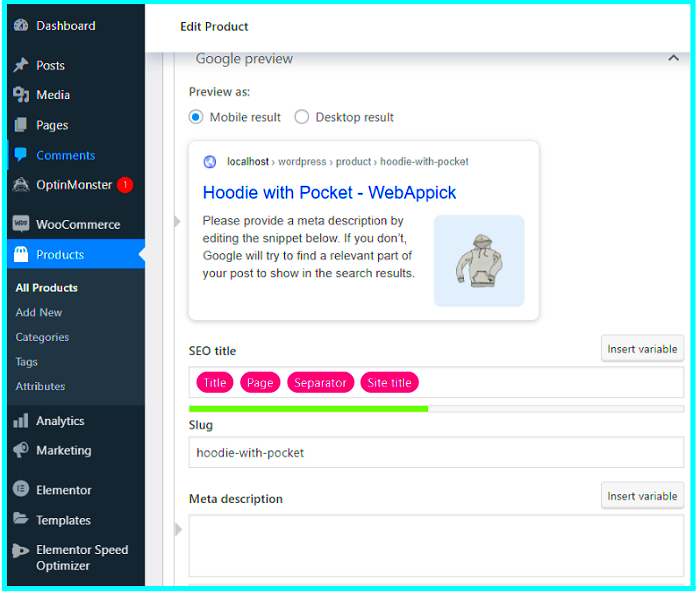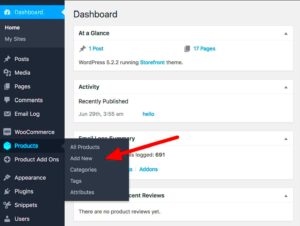WooCommerce Product Schema is a specific type of structured data that helps search engines understand your online store’s product offerings better. It’s like giving search engines a detailed roadmap of each product, highlighting essential information like the product name, price, availability, and reviews. By implementing WooCommerce Product Schema, you’re essentially providing additional context about your products, making them more visible and appealing in search results. Now, let’s break down some key components of this schema:
- Product Name: The official name of your product.
- Description: A brief overview of what the product is and its features.
- Image: A direct link to the product image that helps enhance visibility.
- Price: The cost of the product, which can be a significant factor for potential buyers.
- Availability: Information on whether the product is in stock or back-ordered.
- Aggregate Rating: Average rating based on user reviews to build trust with potential buyers.
When you incorporate this schema into your WooCommerce store, you’re making your products more structured and organized, which allows search engines to deliver richer snippets in search results. This better visibility can significantly impact click-through rates and conversions.
Importance of Product Schema for SEO

When it comes to e-commerce SEO, implementing Product Schema is crucial. It not only helps search engines understand your products better but also enhances the way they appear in search results. Why is this important? Let’s dive into a few key reasons:
- Improved Search Visibility: Products with structured data are more likely to appear with rich snippets, which can include product ratings, pricing, and availability. This additional information catches a user’s eye, potentially leading to higher click-through rates.
- Enhanced User Experience: When users see detailed information right in the search results, they can make quicker decisions, improving their overall experience.
- Higher CTR (Click-Through Rates): Rich snippets usually lead to higher CTR because they stand out more than regular search listings, drawing users in.
- Better Targeting: Product Schema allows you to target specific queries much more effectively, ensuring that your products show up for relevant searches.
- Voice Search Optimization: As more people use voice search, having structured data increases the chances of your products being recommended or highlighted by virtual assistants like Siri or Alexa.
In summary, if you’re looking to boost your e-commerce store’s visibility and performance in search engines, implementing WooCommerce Product Schema is a smart move. It aligns perfectly with SEO best practices and helps you stand out in a competitive market.
How to Implement Product Schema in WooCommerce
Implementing Product Schema in WooCommerce is crucial for enhancing your online store’s visibility on search engines. Don’t worry; it’s easier than you might think! Here’s a step-by-step guide to help you implement Product Schema effectively.
- Install an SEO Plugin:
First things first, you’ll want to install an SEO plugin, like Yoast SEO or Rank Math. These plugins have built-in support for Schema markup and make the implementation process much smoother.
- Access Your Product Settings:
Once your plugin is up and running, navigate to your WooCommerce product settings. You’ll typically find these options under the “Products” tab in your WordPress dashboard.
- Schema Markup in Yoast SEO:
If you’re using Yoast SEO, go to the product you wish to edit, scroll down to the Yoast SEO section, and click on the “Schema” tab. Here, you can customize the markup to suit your product’s specifics.
- Use JSON-LD Format:
You’ll want to use JSON-LD format for your Schema markup. Most SEO plugins will do this automatically, as JSON-LD is the preferred method by Google. It’s clean, easy to read, and integrates seamlessly into your pages.
- Test Your Schema:
After setting up your schema markup, use Google’s Rich Results Test tool to validate it. Enter the URL of your product page and see if any errors need fixing. If everything looks good, you’re all set!
With these steps, implementing Product Schema in WooCommerce will not only become manageable but will serve to improve your SEO, helping your products stand out in search results!
Best Practices for WooCommerce Product Schema
Now that you know how to implement Product Schema in WooCommerce, let’s delve into some best practices that can take your SEO game to the next level. It’s all about optimizing your visibility and ensuring that your products shine!
- Keep Accurate Information:
Always ensure that your product information in the schema matches what’s displayed on your product page. This includes the price, availability, and description. Mismatched information can lead to penalties from search engines.
- Utilize Rich Snippets:
Adding Product Schema allows Google to generate rich snippets, which make your listings more attractive. Use high-quality images and include star ratings if applicable. These elements will grab attention and boost click-through rates.
- Focus on Key Attributes:
Be sure to include key attributes such as:
- Name: The product title
- Image: A high-quality image of the product
- Brand: The brand of the product
- AggregateRating: Average customer review ratings
- Offers: Current pricing and availability
- Stay Updated:
Schema.org updates its specifications regularly. Keep your SEO plugin updated, and stay informed on any changes related to Product Schema to maintain compliance and effectiveness.
- A/B Test your Changes:
Experiment with different Schema types and attributes to see what resonates best with your audience. Monitor the impact on your click-through rates and conversion rates to determine the best configuration for your store.
By following these best practices for WooCommerce Product Schema, you’ll not only enhance your SEO but also improve user experience, ultimately leading to increased sales. So, roll up your sleeves and get to optimizing!
Common Issues and Troubleshooting
When it comes to implementing WooCommerce Product Schema, you might run into a few hiccups along the way. Don’t worry; many people experience these common issues, and they can usually be resolved with a bit of troubleshooting. Let’s dive into some typical problems you might encounter:
- Missing Schema Markup: This can happen if you’re using a theme or plugin that doesn’t support structured data. Always check if your current setup includes built-in schema functionality.
- Incorrect JSON-LD Format: If your markup isn’t in the right format, search engines can’t read it properly. Use a JSON validator to confirm that your code is structured correctly.
- Mixed Schema Types: Sometimes, plugins might generate overlapping schema types. For example, your product may be marked both as an ‘Item’ and a ‘Product,’ leading to confusion. Stick to one schema type for clarity.
- Testing Tool Errors: When using Google’s Rich Results Test or any other testing tool, make sure you’re checking the right URLs. Sometimes, you might have a staging site or development version that lacks the necessary schema.
- Data Quality Issues: Ensure that all required properties are filled out properly. A missing field could cause search engines to disregard your entire schema.
If you find yourself stuck with any of these issues, consider checking support forums or consulting the documentation of your theme and plugins. Oftentimes, a simple update or a few settings adjustments can make a big difference!
Tools for Testing and Validating Schema Markup
After you’ve implemented WooCommerce Product Schema, testing and validating it becomes crucial. You want to ensure that search engines can read your structured data effectively. Luckily, there are some fantastic tools at your disposal:
| Tool Name | Description |
|---|---|
| Google’s Rich Results Test | Use this tool to check if your page is eligible for rich results. It highlights issues and gives detailed feedback. |
| Schema Markup Validator | This tool allows you to validate your markup against the schema.org specifications. |
| JSON-LD Playground | For JSON-LD structured data, this handy tool provides a way to experiment with and validate your code. |
| Structured Data Testing Tool (Retired) | Though retired, some still find value in accessing cached versions for legacy purposes. |
Remember, using these tools not only helps you identify issues but also enhances your understanding of how structured data works. Validating your markup thoroughly ensures that you’re harnessing the full potential of SEO to make your products shine!
7. Case Studies: Success Stories of Using Product Schema
When it comes to boosting SEO, real-world examples can be incredibly inspiring. Let’s dive into some case studies that showcase the success stories of businesses that have implemented WooCommerce product schema effectively.
Case Study 1: A Fashion Retailer
A well-known fashion retailer integrated product schema into their WooCommerce store. Before implementing schema markup, they struggled with visibility in search engine results. After the integration, they saw a remarkable 40% increase in organic traffic within three months. Their products began to appear with rich snippets including price, availability, and reviews, which improved their click-through rate (CTR) significantly.
Case Study 2: An Electronics Store
Another case involves an electronics store that relied heavily on online sales. By adding structured data for their products, they not only enhanced their search engine presence but also experienced a 35% boost in conversion rates. Shoppers were drawn to their listings because they provided extra info at a glance. This case demonstrates how product schema can make listings more attractive to potential customers.
Case Study 3: A Home Decor Brand
Lastly, a home decor brand made the leap to implement WooCommerce product schema and immediately noted a difference. Before the update, their site was buried somewhere on the second or third result page. Post-implementation, they secured a spot on the first page of SERPs for important keywords, which translated to a 50% increase in sales. The product snippets instilled more trust, leading to higher customer engagement.
These case studies illustrate that product schema is not just a technical upgrade; it can lead to significant business growth. Businesses that proactively implement schema find themselves reaping substantial rewards, from elevated search rankings to increased sales.
8. Conclusion: Elevate Your WooCommerce Store’s SEO with Product Schema
In a digital landscape where competition is fierce, every little advantage counts. Implementing WooCommerce product schema can make a world of difference to your store’s SEO and overall visibility. As we’ve seen through case studies, businesses that have adopted this practice frequently enjoy increased traffic, higher conversion rates, and improved customer trust.
So, why should you consider using product schema? Here are a few key takeaways:
- Enhanced Visibility: Product schema adds rich snippets to your listings, making them pop in search engine results.
- Increased Click-Through Rates: Listings with detailed product information are more likely to be clicked on.
- Customer Trust: Providing comprehensive data fosters trust with potential buyers.
- Competitive Edge: By utilizing schema, you can outshine competitors who have not yet optimized their listings.
As you move forward with your WooCommerce store, make product schema a priority. It’s not just another SEO tactic; it’s a fundamental part of ensuring your products stand out in a crowded marketplace. With the right setup, your store could be the next success story worth sharing.
Don’t wait! Start implementing WooCommerce product schema today and watch how it elevates your SEO game.



